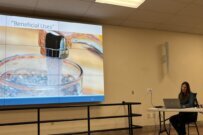Despite finding 17 pesticides in estuary waters and 10 instances of contamination, Water Board has no plans to rein in chemical use
In late January, 2018, the state agency charged with enforcing the federal Clean Water Act released a long-awaited report on the results of two years of water quality testing in the Smith River Estuary. The testing detected 17 pesticides in the streams, creeks and ditches that feed the estuary, and 10 instances of contamination of the aquatic food chain. The findings appear to show that Easter lily farmers are in violation of the Clean Water Act, which was passed in 1972 in large part to protect precious aquatic resources such as the West Coast’s dwindling salmon populations.
Nonetheless, officials at the California North Coast Regional Water Quality Control Board say that the widespread contamination of estuary waters requires no action because it is occurring primarily due to “extremely low water hardness” which is “interfering with the ability of the test species to reproduce.”
This conclusion is clearly erroneous and appears to bely the evidence of the state’s own water testing results. Five of the pesticides found in the estuary occurred at levels that exceed the Environmental Protection Agency’s Aquatic Life Benchmarks, meaning they are considered hazardous to fish and other creatures. High levels of copper — which is extremely toxic to fish and is used widely in Smith River as a pesticide — were found in every water sample. When small aquatic organisms that make up the basis of the salmonid food chain were exposed to the water in a laboratory, many of them either died or failed to reproduce.
The new report — the Smith River Plain Surface Water and Sediment Monitoring Report — builds on previous rounds of testing that also found the estuary’s water to be toxic and contaminated with pesticides.
Most of the land surrounding the Smith River Estuary is used to produce Easter lily bulbs, a process that uses 300,000 pounds of toxic pesticides annually. The Water Board report notes that “agricultural activities on the Smith River Plain are affecting the water quality” in the estuary. However, in a conference call with stakeholders prior to the report’s release, Water Board staff stated that its findings of widespread contamination can not be attributed to the 17 toxic pesticides found in surface waters. The contamination is occurring due to the water’s “lack of hardness,” said one of the scientists as well as the report. Water Board staff said they planned to ask the lily growers for “voluntary” actions and “best management practices” to address possible pesticide exposure.
“This is one of the worst examples I’ve ever seen of the Regional Water Board ignoring its own science in order to avoid enforcing state and federal laws,” said Greg King, Executive Director of Siskiyou Land Conservancy, which has sought reductions in Smith River pesticide use since 2004. “It’s unbelievable that the state sees no problem with these extreme levels of contamination in the waters of one of the most important salmonid streams on the West Coast.”
Since 2013, the Water Board has been in the process of developing a “discharge permit” that would regulate the practices of lily bulb growers in the estuary. However, the new report indicates that the Water Board may be abandoning that kind of regulation altogether. The report lists a “waiver” or a “monitoring order” as other options, but does not provide any detailed plan for further action.
“We now know that getting rid of pesticides on the Smith River Plain is needed to stop the decline of salmon and steelhead populations in this fabled river,” said King. “These findings require more than voluntary measures. Once again the Water Board has completely abandoned its mandate. It’s as if first responders were blocking the doors of a burning building, disallowing firefighters from getting in.”
Dr. Ken Miller, a Humboldt County physician and SLC director who for three decades has studied the ecological and human impacts of pesticide exposure, was shocked by the Water Board’s apparent abandonment of the Smith River estuary, and the people who live nearby.
“In those three decades I have not seen such an imminent health and safety threat to a community or its precious estuary environment as posed by these pesticides,” said Miller. “To see this obvious danger swept under the rug with such indifference by the Regional Water Board raises serious concerns of incompetence, or worse, malfeasance.”


